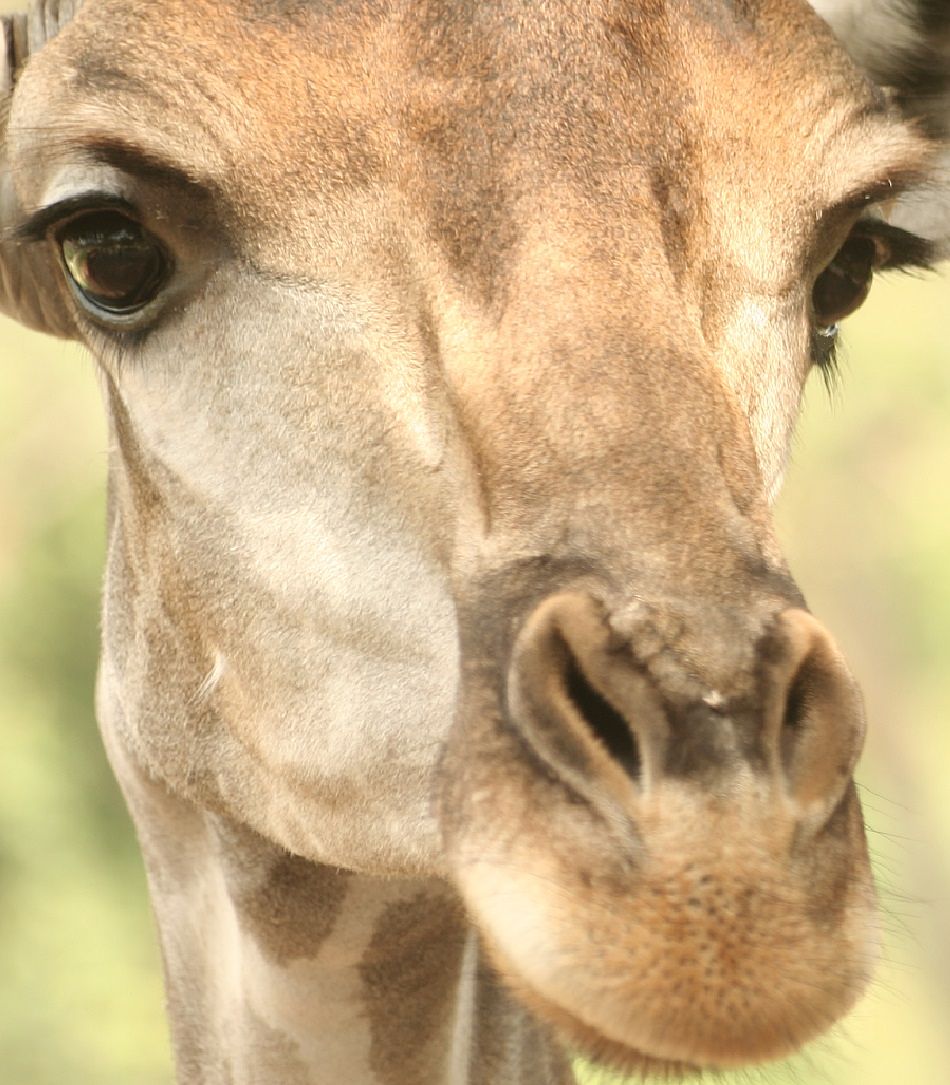giraffe Facts
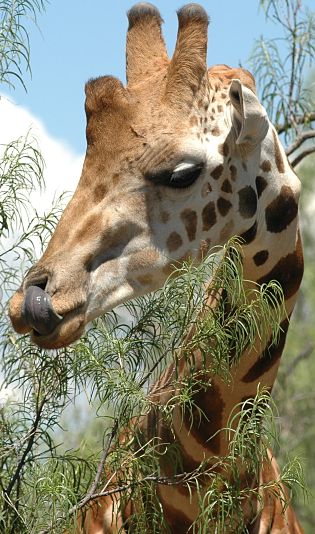 Portrait of a Giraffe
Portrait of a GiraffeThe giraffe and its closest relative the okapi are the last survivors of the once plentiful Giraffidae family. While the okapi is a solitary, forest dwelling creature rarely seen, the giraffe is a true show stopper, herds of which wander in surprising abundance across the African savanna.
Today the giraffe is the tallest animal on Earth, with males topping out at about 18 feet at the tip of the horns (called occicones), and 11 feet at the shoulder.
Although no fossil trail exists, it is assumed the giraffe developed its remarkable physique and out-survived its relatives, by reaching for the treetops.
As taller individuals ate leaves and fruits unavailable to shorter individuals, the giraffe thrived, and became more and more specialized. While the 6 to 8 foot long, 600 pound neck is most obvious, the giraffes entire body is a masterpiece of specialization.
Viewed from the side, the giraffes shoulder region is towering, with a highly elongated pectoral girdle which gives the illusion that the front legs are longer than the rear. Front and rear legs are about the same length, however, between 5.5 and 6 feet long.
While the relatively short back has vertebrae of a median size, the vertebrae of the neck, are stretched to about 11 inches long, They still have the standard 7 neck vertebrae found in most mammals, including us, but they are not only elongated, but also articulate far more than ours.
The neck is supported by powerful muscles and reinforced ligaments which anchor to vertebrae between the shoulder blades, and form a hump where the back and neck meet.
The head is refined, streamlined and equipped with an 18 inch long tongue for even further reach.
Both males and females have horns known as "occicones", which are formed from cartilage and covered with skin. Females have thinner occicones, that are tufted with longer hair on top. Males occicones are larger, have knobs on the ends, and become bald on top as they mature.
Giraffes live in very loose groups of 3 to 40 or so, mostly related individuals. They are not territorial, and their social structure is very peaceful and cooperative..
Though the giraffe is the worlds tallest animal, it is, by mammal standards, remarkably peaceful, with very little territorial drive. Even aggression between adult bulls is limited to largely harmless "necking" displays.
Males and females mingle, young are protected by herd members, and individuals take turns looking out for eachother while drinking or napping.
Giraffes have a "fission-fusion" society, that means groups come together and break apart freely, and friendships and alliances are loose and varied.
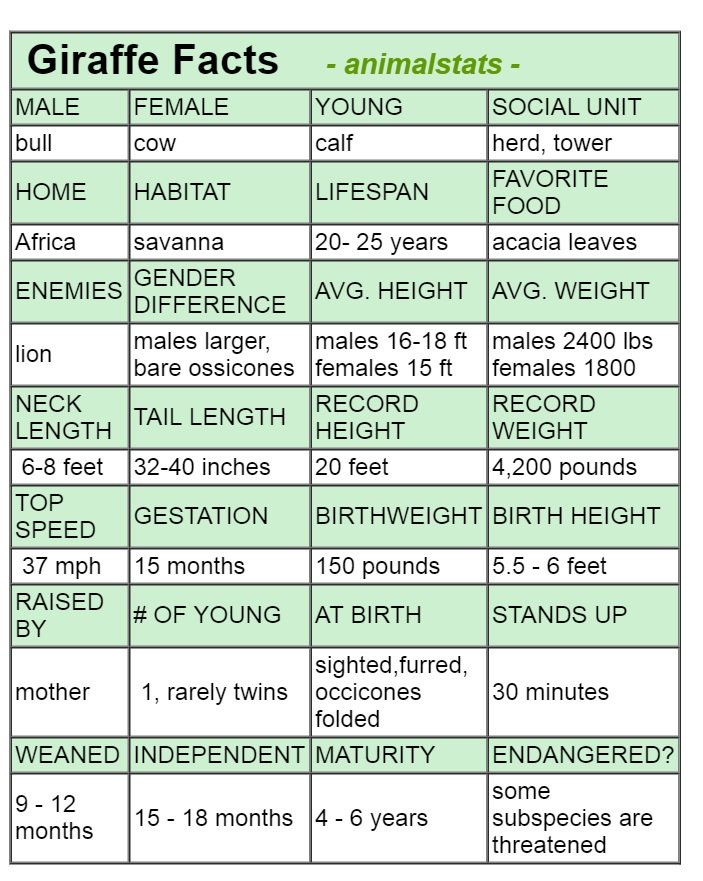
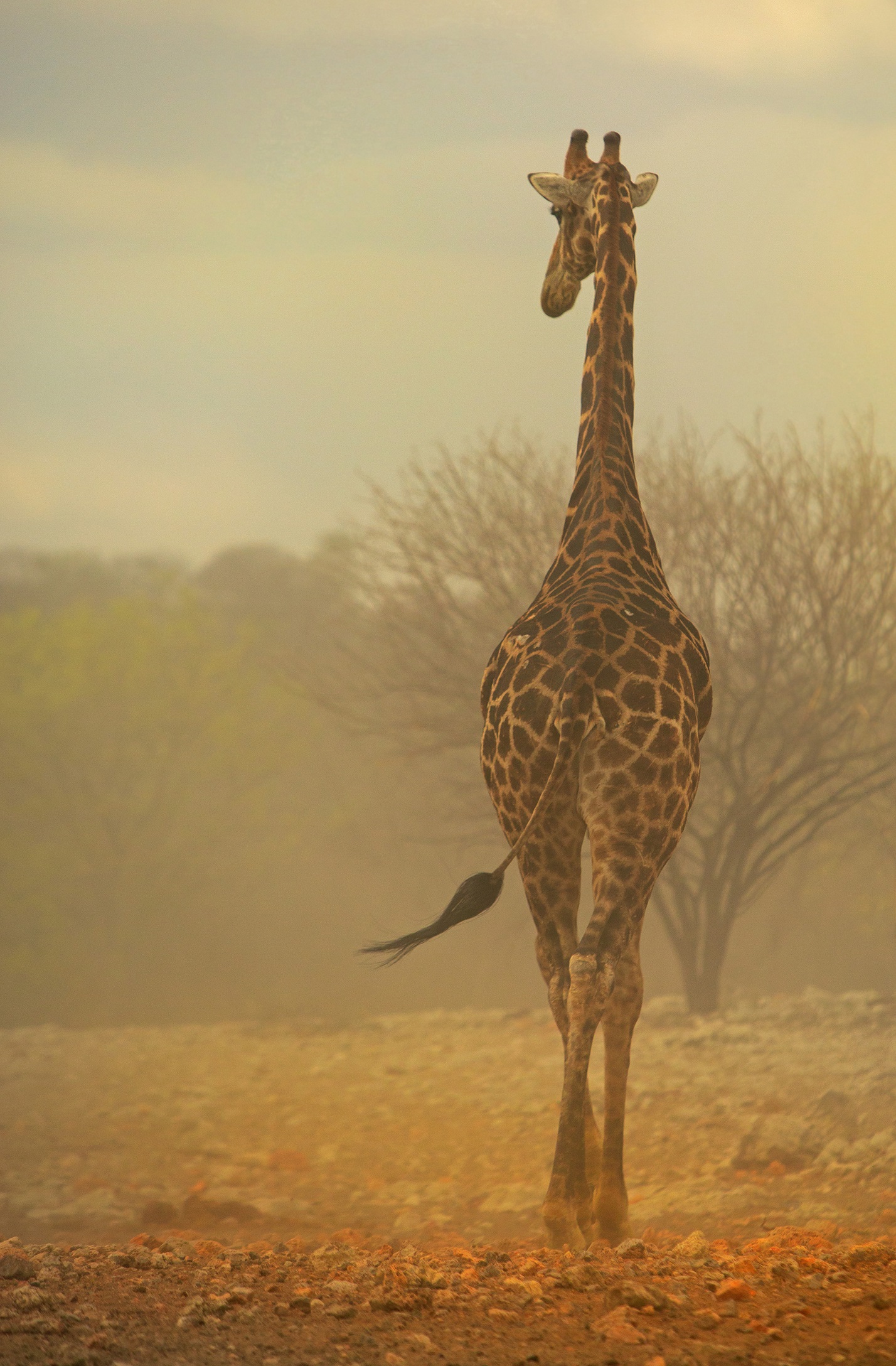
What Sound Does a Giraffe Make?
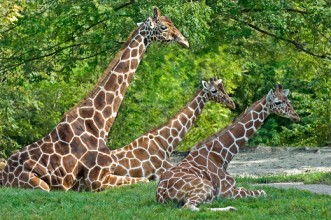
While some may incorrectly report that giraffes make no sounds at all, they are, in fact, diverse in vocalizations, emitting grunts, snorts and flute-like noises of different meaning. Giraffe vocalizations are infrequent, however, and are usually at very low volume.
The loudest giraffe calls are from baby giraffes separated from their mother - these are robust, guttural grunts that sound very much like the calls of large adult deer such as elk.
The length between lungs and vocal chords could be the reason why there is a limit on the production and volume of giraffe noises, but new research has also found that giraffes make sounds we simply can't hear because they are at too low a frequency.
In 2015, it was discovered and documented that giraffes in zoos hummed to eachother. This humming was only at night, and only in the dark, and far too low for humans to hear. - Amazing!
how do giraffes sleep?
Because they are always on the move and always eating, even overnight, t was once thought that giraffes never sleep. After lots of observation it was discovered that the giraffe sleeps 1 or 2 hours a day, and usually only a few minutes at a time. Adults generally sleep standing up, while youngsters lie down and rest their head on their rump.
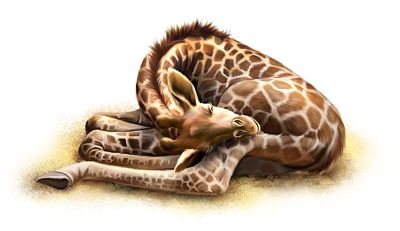
What do giraffes eat and how do they drink?
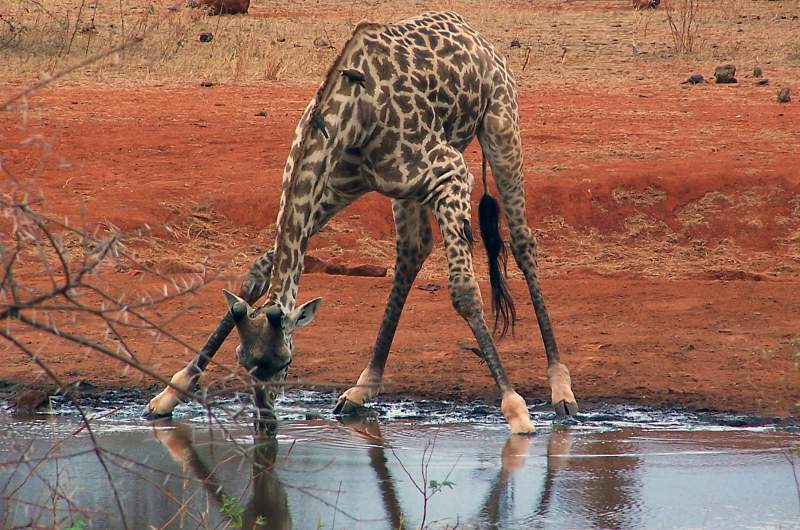
Like cows, giraffes have multiple stomach chambers and "chew their cud", meaning they regurgitate partially digested food back up their 6 foot long throat, to re-chew it one mouthful at a time.
With this method, they get as much nutrients as they can from the leaves and fruits they consume.
The giraffes top lip, and its 18 inch long tongue, are not only prehensile, allowing them to grasp leaves and branches, but are also extraordinarily tough, protecting them from damage as they munch on the leaves from their favorite tree the Acacia - which has 3 inch long thorns!
Giraffes have a hard thickness of tissue called the "dental pad" in place of the top front teeth, which they grind their food against.
Giraffes are some of the largest land animals, and need up to 70 pounds of food a day to survive. They spend almost all of their time grazing among, tall branches for herbs, vines, flowers and fruits, but will lower their heads and graze off the ground if something is tempting enough.
Because their legs are so long, they must either bend the front legs, or spread them awkwardly wide, especially to drink. This is a vulnerable position for them, and herd members will take turns looking out for predators while others drink. They can go for long periods without water, and regularly go for days without a drink.
What are giraffe predators?
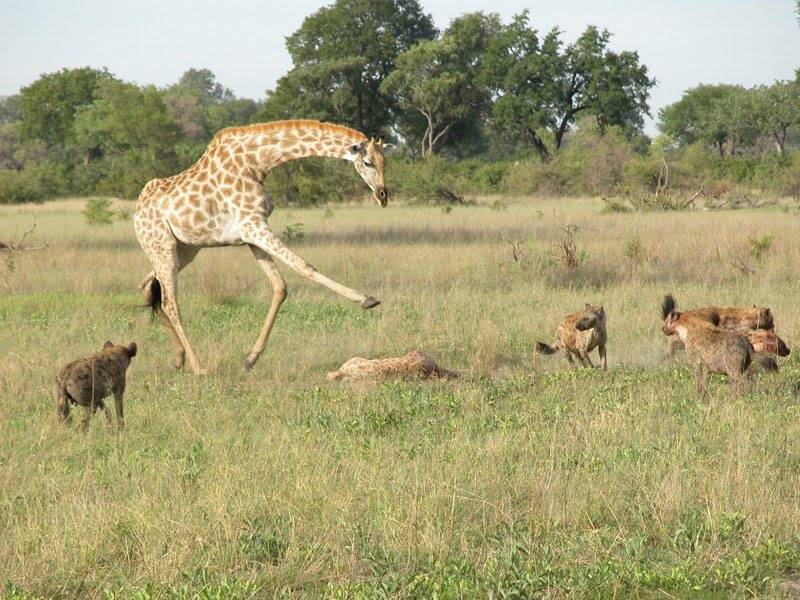 Giraffe kills a hyena
Giraffe kills a hyenaBecause of their immense size, healthy adult giraffes have little to fear out on the savanna. They are extremely cautious, with excellent hearing and eyesight, and effortlessly swift if they spot danger. But more importantly, a giraffes kick can be lethal to even the largest predator.
Giraffes have been known to kill leopards, hyenas, African wild dogs and adult male lions with a few - and sometimes just one- well-aimed strikes. They can kick with front and rear legs, and are simply too great a risk for even the hungriest on the plains.
While they are still young, however, giraffe calves may fall prey to any of the large predators on the Savanna. Mothers will try to defend their young, but about half of the baby giraffes born will be lost in the first 6 months.
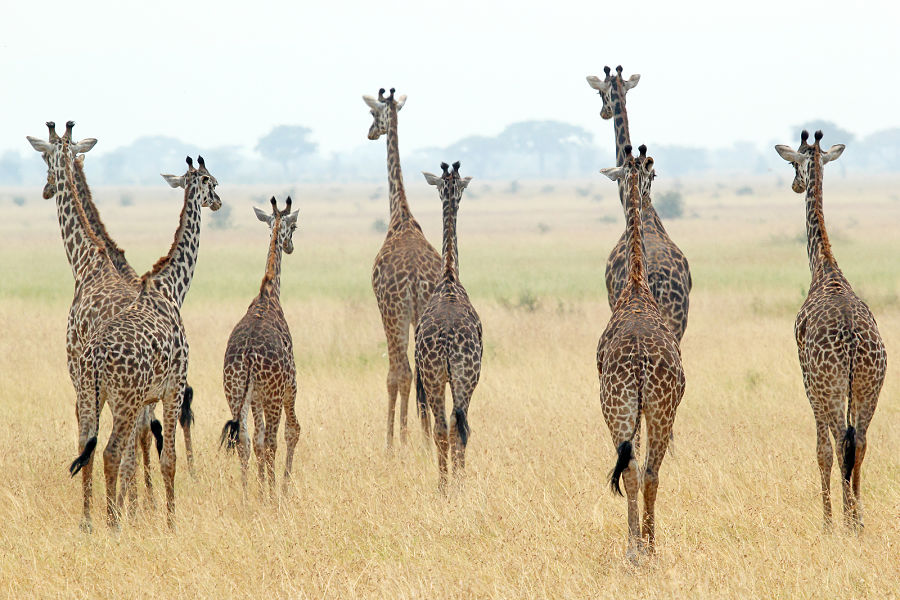 herd of Masai girrafes
herd of Masai girrafesa few more giraffe facts
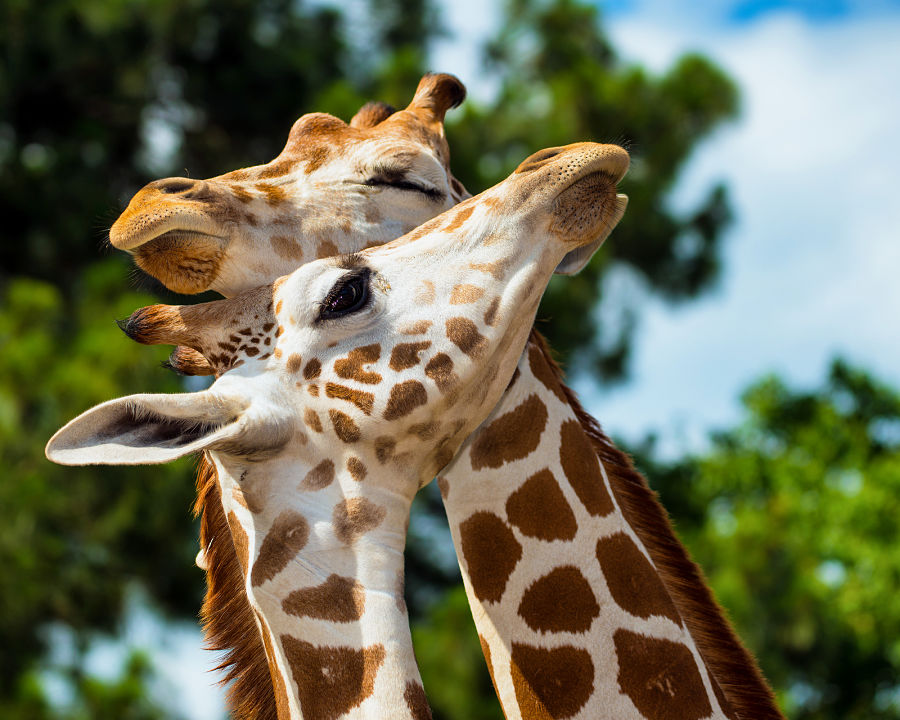 giraffes snuggling
giraffes snuggling- The giraffe is the largest ruminant and the worlds tallest animal
- Male giraffes can be 18 feet tall at the top of the horns
- Giraffes have 2 to 5 horns called "occicones"
- The giraffes neck is 6 to 8 feet long and can weigh over 600 pounds
- Giraffes "chew their cud" just like cows
- Giraffes defend themselves by kicking
- A giraffes kick can kill a lion!
- The giraffes tongue is about 18 inches long
Scientific Classification:
| Giraffe Facts - animalstats - | |||
|---|---|---|---|
| MALE | FEMALE | YOUNG | SOCIAL UNIT |
| bull | cow | calf | herd |
| HOME | HABITAT | LIFESPAN | FAVORITE FOOD |
| Africa Asia | savanna | 20-25 years | acacai leaves |
| ENEMIES | GENDER DIFFERENCE | AVG. HEIGHT | AVG. WEIGHT |
| lion | males larger | 16-18 feet | 1800-2400 pounds |
| TOP SPEED | GESTATION | BIRTHWEIGHT | BIRTHHEIGHT: |
| 37 mph | 15 months | 150 pounds | 5.5-6 feet |
| RAISED BY | # OF YOUNG | EYES OPEN | STANDS UP |
| mother | 1, rare twins | at birth | 30 mins |
| WEANED | INDEPENDENT | MATURITY | ENDANGERED? |
| 9-12 months | 15-18 months | 4-6 years | some subspecies |
see more animal extreme closeups
Recent Articles
-
African Animals - Animal Facts Encyclopedia
Oct 11, 16 10:27 PM
African Animals facts photos and videos..Africa is a wonderland for animal lovers, and a schoolroom for anyone who wants to learn about nature, beauty and the rhythm of life -
Baboon Facts - Animal Facts Encyclopedia
Oct 11, 16 10:26 PM
Baboon facts, photos, videos and information - Baboons are very distinctive looking monkeys with long, dog-like snouts and close set eyes. -
Great Apes Facts - Animal Facts Encyclopedia
Oct 11, 16 10:25 PM
Great apes facts, photos and videos..Human beings did not evolve from chimpanzees, modern chimps and gorillas do not appear in the fossil records until much more recently than homo sapiens..























